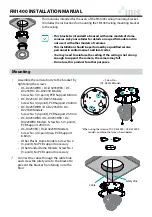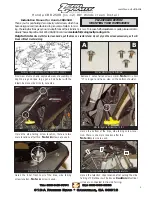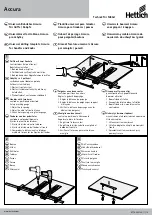
Do not block sensor openings as this may cause inaccurate readings.
Do not press on the face of the sensors, as this may damage them and
cause erroneous readings. Do not use compressed air to clean the
sensor holes, as the pressure may damage the sensors.
Allow sufficient time for unit to display accurate reading. Response
times vary based on the type of sensor being utilized (see Section 5.3,
"Sensor Performance Specifications"). For units with a sample pump,
allow a minimum of 1 second per foot (3 seconds per meter) of sample
line to allow the sample to be drawn through the sensors.
Sampling lines made from 0.062 inch (1.57 mm) inner diameter tubing
provide fast transport times to the instrument; however, they must be
limited to 50 feet (15 m) in length.
Sampling of reactive toxic gases (Cl2, ClO2, NH3) must only be done
with the reactive gas sample line and probe kits listed in the
Accessories table in Section 6.2.
All instrument readings and information must be interpreted by
someone trained and qualified in interpreting instrument readings in
relation to the specific environment, industrial practice and exposure
limitations.
Observe proper battery maintenance
Use only battery chargers made available by MSA for use with this
instrument; other chargers may damage the battery pack and the
instrument. Dispose of in accordance with local health and safety
regulations.
Be aware of environmental conditions
A number of environmental factors may affect the oxygen and toxic
sensor readings, including changes in pressure, humidity and
temperature. Pressure and humidity changes affect the amount of
oxygen actually present in the atmosphere.
After exposure to negative (°C) temperatures, units with HCN (hydrogen
cyanide) sensors should be bump checked and calibrated, if necessary,
after returning to room temperature.
Be aware of the procedures for handling electrostatically sensitive
electronics
The instrument contains electrostatically sensitive components. Do not
open or repair the unit without using appropriate electrostatic discharge
(ESD) protection. The warranty does not cover damage caused by
electrostatic discharges.
1-4
Summary of Contents for altair 5
Page 68: ...6 3 Instrument Replacement Parts 6 3 ...
Page 71: ...7 Appendix Flow Charts 7 1 Start Up Sequence Power ON 7 1 ...
Page 72: ...7 2 Normal Operation 7 2 ...
Page 73: ...7 3 Options from Main Page 7 3 ...
Page 74: ...7 4 Password Protected Options 7 4 ...
Page 75: ...7 5 Menu Sequence from Main page 7 5 ...
Page 76: ...7 6 ...
Page 77: ...7 6 Calibration Sequence 7 7 ...
Page 78: ...7 7 Calibration Options 7 8 ...
Page 79: ...7 8 Alarm Options 7 9 ...
Page 80: ...7 8 1 Sensor Alarm Options 7 10 ...
Page 81: ...7 9 Instrument Options 7 11 ...
Page 150: ...6 3 Pièces de rechange pour l appareil 6 3 ...
Page 232: ...6 3 Piezas de repuesto 6 3 ...












































